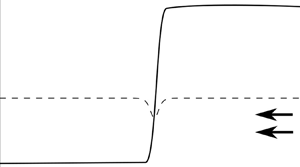No CrossRef data available.
Article contents
Hydraulic control of continental shelf waves
Published online by Cambridge University Press: 21 April 2021
Abstract

This paper studies the hydraulic control of continental shelf waves using an inviscid barotropic quasi-geostrophic model with piecewise-constant potential vorticity, in which the shelf is represented by a flat step of variable width. A coastal-intensified geostrophic current generates topographic Rossby waves, which can become critical at a local decrease in shelf width when the background current opposes Rossby wave propagation. That is, the shelfbreak perturbation permanently modifies the flow field over arbitrarily large distances and the flow transitions from subcritical to supercritical as it crosses the perturbation. Critically controlled flows also lead to the exchange of significant volumes of water between the shelf and the deep ocean. We derive the boundaries for which critical control occurs in terms of a Froude number and the dimensionless magnitude of the perturbation, and analyse the possible transitions between controlled and far-field flow. When first-order dispersive terms are included in the model, transitions are resolved by dispersive shock waves, which remain attached to the forcing region when the Froude number is close to the boundary for critical flow. Contour dynamic simulations show that the dispersive long-wave model captures the quantitative behaviour of the full quasi-geostrophic system for slowly varying shelves, and replicates the qualitative behaviour even when the long-wave parameter is order one.
- Type
- JFM Papers
- Information
- Copyright
- © The Author(s), 2021. Published by Cambridge University Press



